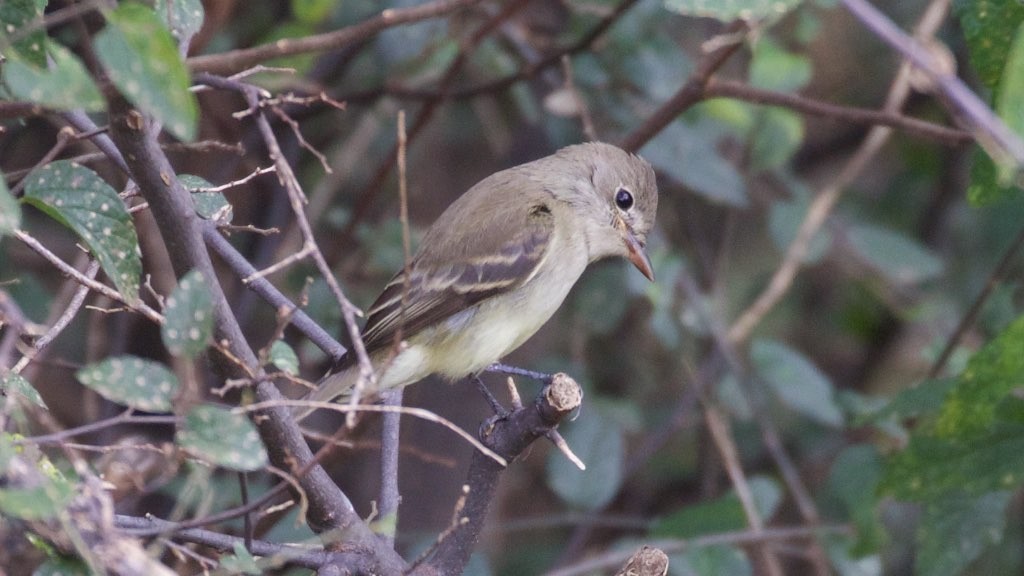Gray Flycatcher
A species of Empidonax flycatchers, Also known as Grey Flycatcher Scientific name : Empidonax wrightii Genus : Empidonax flycatchers
Gray Flycatcher, A species of Empidonax flycatchers
Also known as:
Grey Flycatcher
Botanical name: Empidonax wrightii
Genus: Empidonax flycatchers
Content
Description General Info
Description
American gray flycatchers are small birds, but larger than most Empidonax flycatchers. A typical adult measures 15 cm (5.9 in) in length, 22 cm (8.7 in) in wingspan, and 12.5 g (0.44 oz) in mass. Adults have pale gray upperparts, darker on the wings and tail, with a faint olive tinge after molting in fall. Underparts are whitish, but washed slightly with yellow in fresh plumage. They have white wing bars and an inconspicuous white eye ring. There is a pale supraloral band stretching above the base of the bill. Relative to other North American Empidonax flycatchers, the American gray flycatcher has a long, narrow bill, a long tail, and the mandible tends to be paler for more of its length. Juveniles are similar in appearance to adults, but with stronger olive and yellow tones. Also, young birds have buffy wing bars and brownish breasts. Only the male sings. The song is a strong, two syllable note described as chuwip or wilip. A weaker, higher-pitched teeap or seep is often inserted into the song. Both sexes give a dry pit or wit call. Females call often when foraging or collecting nest materials. 
Size
15 cm (6 in)
Nest Placement
Shrub
Feeding Habits
Gray Flycatcher feed primarily on insects, using a sally-hunting technique from perches, often dead branches. They predominantly capture prey mid-air, from vegetation, or the ground, where they forage more than their counterparts. Diet includes beetles, grasshoppers, wasps, moths, ant lions, and likely small fruits seasonally.
Habitat
Gray Flycatcher inhabits open woodlands and shrub-steppe regions within semi-arid to subhumid climates at elevations of 2,000 to 7,800 feet. They are associated with the Great Basin's 'sagebrush sea', preferring tall sagebrush, hardy brushy vegetation like saltbush and manzanita, and evergreens such as junipers and pines. Migration habitats include riparian zones, while wintering grounds expand to mesquite bosques and thorn forests.
Nest Behavior
Gray Flycatcher females exclusively build the nest, after which they lay eggs and along with the males, participate in parental care. The timing of nest building and egg-laying patterns are consistent with typical flycatcher behavior.
Nest Characteristics
The gray Flycatcher constructs a broad, coarse cup-shaped nest in evergreen trees or shrubs, often pine or juniper. Located near the trunk and typically under 10 feet high, the nest is built with grass, sage, fibers, pine needles, and bark, with a lining of grass, wool, hair, feathers, and plant down. It averages 5 inches in width and 2.4 inches in height, with an inner cup about 3 inches wide and 2 inches deep.
Dite type
Insectivorous
General Info
Feeding Habits
Bird food type
Bird Feeder Type

Platform
Behavior
The gray Flycatcher, monogamous by nature, commences its cycle by males claiming territories through song and exclusion of competitors upon return from wintering zones. These areas can extend from 2.5 to 13 acres, where they often vocalize from low perches. During disputes, males exhibit a distinctive rattle call and aggressive posturing such as crown feather raising, tail spreading, and bill snapping. The courtship ritual involves aerial displays and expressive perching by males. Females predominantly undertake nest construction, with males assisting sporadically. Post-egg-laying, territorial tendencies wane, with males primarily singing at dawn. Both parents are diligent in feeding their offspring. While migrants are quiet, wintering gray Flycatchers may exhibit some territorial behavior through calling. Their appearance evolves post-breeding season into worn, predominantly gray plumage, with a noteworthy post-migratory molt.
Distribution Area
The American gray flycatcher breeds from southernmost British Columbia through a narrow zone in central Washington to eastern Oregon and California. The range extends east across Nevada, southern Idaho, Utah, and northern Arizona to southwestern Wyoming, western Colorado, and northwestern New Mexico. Depending on latitude, they arrive on breeding grounds mid-April to mid-May and leave between mid-August and mid-September. Migration between breeding and wintering grounds takes approximately seven weeks in both spring and autumn. Males usually arrive on breeding grounds one week prior to arrival of females. The American gray flycatcher winters in Baja California Sur, southeastern Arizona, and central Sonora to central Oaxaca. Small numbers may winter in western Texas and southern California. 
Species Status
Not globally threatened.
Scientific Classification
Phylum
Chordates Class
Birds Order
Perching birds Family
Tyrant flycatchers Genus
Empidonax flycatchers Species
Gray Flycatcher 